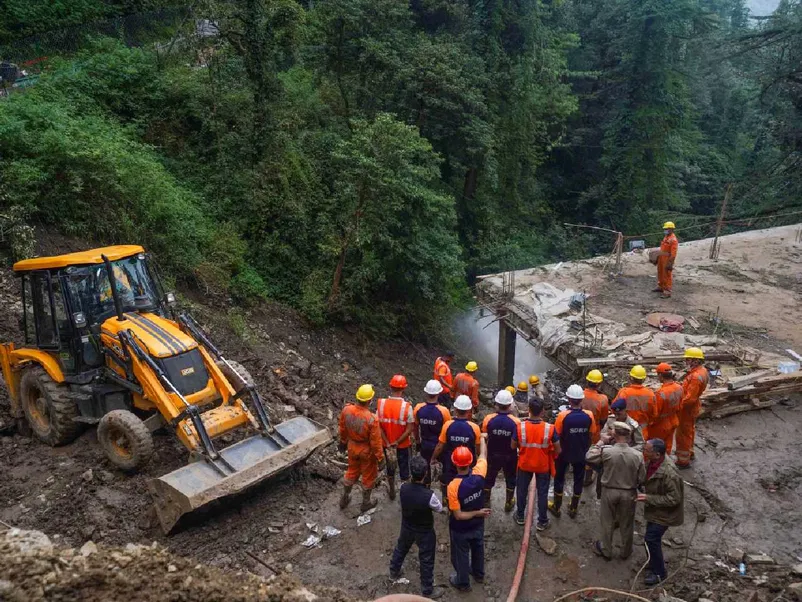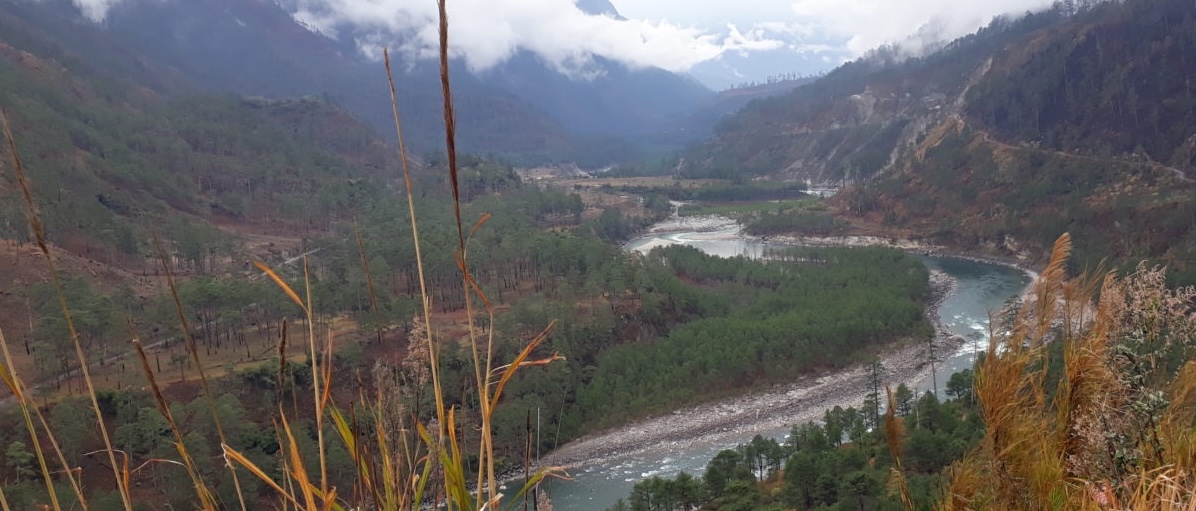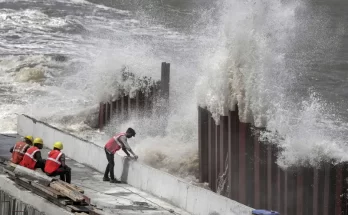Himachal suffered the consequences of unbridled urbanisation while Uttarakhand’s Queen of the Hills gained from restoring its green cover.

NDRF personnel carry out search and rescue operation after a landslide following incessant monsoon rains, in Shimla. (Photo credit: PTI)
New Delhi: The last 10 days were dominated by disturbing visuals from the hill states of Himachal Pradesh and Uttarakhand. A nursing training college fell like a pack of cards in the flooded river at Dehradun’s Maldevta area. A few hundred kilometres away, following a dangerous landslide, a set of multi-storied buildings and a temple tumbled down on upon another in Summer Hill area of Shimla, killing about dozen people.
In fact, the landslide not just pulled down those houses with it but also affected the prestigious Indian Institute of Advanced Study (IIAS) in Shimla. The landslide, apparently triggering from the edge of the outer lawns of IIAS’ premises, prompted the institute’s officials to write to the government for a risk assessment survey.
“Most of the hill stations are struggling to sustain the increasing pressure of human activities and unplanned concretisation. We should take into consideration the rock foundation, slope stability criterion and also the fragility of hill slopes plus hydrological conditions before any structure is built,” said Harsh Vats, a Uttarakhand-based geology researcher.
“For example, Joshimath town in Uttarakhand was built over the debris of an old landslide. It also falls in Seismic Zone 5 with the highest risk of an earthquake and is equally susceptible to landslides,” Vats said, adding, “The faults and lineaments present in the area should also be taken into consideration for any type of development activities.”
However, amid widespread devastation, loss of life and damage to property across the Himalayan states, one area stood out. Even when there was almost equal quantum of rainfall – matching the 80 mm-100 mm plus record rainfall at several places across the two states – the damage and loss of lives was almost negligible in Uttarakhand’s Mussoorie.
Known as the Queen of the Hills, Mussoorie, about 35-kms from Dehradun, has had a violent past, with its hills bearing the scratches of massive lime quarrying. Almost on the verge of dying, the town and the surroundings saw a quiet revival when in 1980s after the mining was stopped, the then Prime Minister Indira Gandhi ordered a green restoration of the region.
Shimla’s trail of destruction
With large swathes of highways and smaller roads washed away, and a number of houses being damaged, hundreds of acres of already-scarce fertile land have also gone under water.
In fact, Shimla saw maximum devastation across the state in August just as the Kullu valley had witnessed it in July. Cumulative statistics from Himachal Pradesh’s State Emergency Operations Centre (SEOC) for the duration from June 24 (when the monsoon rains started) and August 20 show that there were as many as 341 people dead across the state, with 79 in Shimla district alone, while 38 persons are missing, 19 from Kullu district alone.
The SEOC has maintained detailed records for missing persons that includes those who died due to drowning, landslide, floods, cloudburst etc. The loss of livestock included 9,930 poultry birds, 6,088 four-legged animals, including cows and buffalos, calf donkeys, horses, goats & sheep.
Summing up the situation, Vimlendu Jha, an environmentalist and founder of Swechha, an NGO working on green issues, took to X, formerly known as Twitter, and posted a thread: “Over 100 lives lost due to floods and landslides caused by incessant rain. Unplanned construction activities like road widening, tunnelling, and blasting for highways, as well as hydroelectric projects, have contributed to this tragedy. The consequences are dire: washed-away roads, homes, and villages. The failed drainage system and soil erosion are evident. The push for economic growth through NHAI construction and rapid hydro-power plant development has come at a heavy cost.”
But it was not just Shimla. Large parts of Uttarakhand too had witnessed much damage this monsoon.
Terming it as a case of “extremely casual, extremely apathetic and extremely condemnable” of the powers that be, Anoop Nautiyal of Social Development for Communities (SDC) Foundation, Dehradun, said: “There are SOPs and numerous court and National Green Tribunal (NGT) directives. And yet such disasters keep happening. When something happens, the government rushes to take remedial action, announces compensation etc. Why is it that things are not implemented in the manner in which they should be beforehand, before any disaster strikes?”
The Mussoorie model
This hill city is located in the fragile Shivalik Hill ranges. It was the 80s when the beautiful tourist destination was on the brink of losing its magnificence due to what the environmentalists described as “the most unscientific and illegal mining of limestone.”
The illegal and unorganised mining activity had already led to massive habitat destruction and deforestation in the Mussoorie Hills. “It was then that the then Prime Minister Indira Gandhi was alerted about the destruction, and she personally visited the area. It was suggested that the Indian Army’s then recently formed Eco Task Force be deployed for restoration work,” said Shiv Kunal Verma, Indian military historian and documentary maker involved in environmental activities in the Himalayas.
It was only the Indian Army that could take up the restoration work for the ecological restoration on a war footing. But as regular army could not be deployed for this purpose, a Territorial Army unit comprising ex-servicemen from the region was suggested and raised.
Thus, a first-of-its-kind experiment with a dual aim – resettlement of the ex-servicemen and restoration and regeneration of the ecology – was achieved with setting up of the 127 Infantry Battalion (Territorial Army) on December 1, 1982.
“The idea was that this Ecological Task Force (ETF) Battalion/s would restore any given degraded area by planting shrubs, plants and trees – a three-layer canopy forest and that was exactly what it did for the Mussoorie Hills,” Verma said.
Over the years, the hills started recovering. “Indeed,” pointed out Deepak Rawat, a resident of Mussoorie, “Mussoorie is a very good example of finding out how incredible the regenerative capacity of the nature, when left undisturbed, is.”
Also, Mussoorie has followed the developmental norms pretty strictly. “For instance, one just cannot cut a single tree,” Rawat said, adding, “If not fully, there are certain efforts to reign in reckless tourism here.”
In fact, construction has been banned in Mussoorie’s “freeze zone” areas since 1996 and, recent media reports suggested that a state-government committee had observed and mentioned as part of its report to the NGT in connection with reining in excess tourism in the region, how “the recent extension options require careful monitoring by the Mussoorie Dehradun Development Authority (MDDA)” and “the high influx of tourists exacerbates issues such as unregulated construction, excessive waste generation, sanitation and sewage problems, water scarcity, congested roads, traffic congestion, and vehicular pollution”.
It was the mitigation action by way of restoration of the ecology by the Eco Task Force that saved the day for Mussoorie.
Post-disaster measures
There are certain positive developments – albeit viewed with scepticism by residents and environmentalists – over the weekend. The government authorities from multiple departments have started assessment of the damage in Shimla and other areas of Himachal Pradesh. Chief Minister Sukhvinder Singh Sukhu on Sunday demanded an additional relief with a customised package “considering the state’s geographical conditions and the severity of the disaster”.
Recently, the Uttarakhand State Disaster Management Authority (USDMA) announced it will embark on a study to carry out load-bearing capacity of its major towns.
It has identified 15 towns, including Mussoorie, that are the most popular tourist destinations, for the first phase and the “scientific and technical study” would commence soon after the monsoon. “On the basis of the recommendations of this study, further construction work would be approved in the towns in the hill areas,” Uttarakhand CM Pushkar Singh Dhami had said.
But that would be akin to applying medicine to a current injury. Experts suggest long-term measures.
“Sarkar, Samaj aur Bazar (Government, Community and Traders/Consumers) are the three parties with vested interests. The urgent need is for the government to get its act together. Enforcing the law of the land – following it and applying it on other stakeholders – is a must,” said Nautiyal of SDC Foundation.
Verma suggested, “What was done in Mussoorie is easily possible in other parts of India. Not just in the hills but in each of the 700-plus districts, raising of its own eco-battalion is a must. These task forces can work on a customised selected field, be it horticulture, sericulture, water bodies or even wildlife and carry out greening of the hills and other geographies.”
According to Territorial Army officials, since their inception, the ETF Battalions across eight states have planted approximately 6.88 crore saplings and covered an area of 72,741 Ha of land with survival rate of 75-80% and the ecological activities have helped towards disaster mitigation with a proven track record. “So, there is no reason, why it cannot be replicated in other geographies,” Verma added.
(This story first appeared on news9live.com on Aug 21, 2023 and can be read here.)



